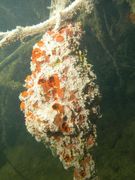Federico Villalobos, BS, MSc
Forest, Estuarine, and Marine Ecology : Understanding the Genetic Dynamics of Natural Ecological Communities and Populations
1. A Long-Term Study of the Community Ecology of Tropical Rainforest Trees, 2001-
Since 2001 the overall aim of the present study has been to investigate some of the mechanisms responsible for both the high diversity of species, and the great variety of population structures among those species, in 2 rain forests in Santander deparment, Colombia. Predictions of some hypotheses proposed to explain this high diversity have been tested non-experimentally by comparing analyses of population dynamics with patterns predicted from the hypotheses. This method was applied by some researchers in testing predictions of the compensation hypothesis. Rates of recruitment, growth and mortality were compared to relative abundances of species to see whether frequency-dependence was occurring among species. Because the smaller stages (seedlings and saplings) have greater sample sizes and faster dynamics than the larger trees, I have concentrated our attention on the former. They are also more suitable for field experimental manipulation.
In my BS thesis I researched the role of disturbance-generated light gaps in the regeneration of canopy trees in a tropical forest. The roles of interspecific competition, herbivory by insects and human disturbances, propagule dispersal and various edaphic factors in gap regeneration were being investigated. I employed a blend of detailed sampling to document spatial and temporal variation and controlled field experiments to test alternative hypotheses for the observed patterns of variation.
Estuarine Ecology
2. A Long-Term Study of the Community Ecology of Mangrove Prop Roots, Bahía de Cispáta, Golfo de Morrosquillo, Colombia, 2004-.
I have made observations of the recruitment, relative abundance and diversity of all sessile species in mangrove prop roots in our study sites, over temporal scales ranging from 2 months up to 3 years, and spatial scales from mm to 2 km. At sites in 4 different shallow water habitats, we established permanently-marked sets of roots, and have censused these using photographs, at intervals ranging from 2 months to 3 years. Two sites were located on the wave-exposed north side of Bahía de Cispáta (Mestizos and Terraplén), 2 others on the more sheltered southwest side (Sabalera and Humadera). In addition, in later years I have sampled larger areas on permanently-marked belt transects and line transects and have continued to census them to 2006. Some of the transects are in the same habitats as the permanent roots. With my colleagues C.B. García, and S. Zea, we have analyzed the population dynamics and interactions between some species on the permanent roots.
My MSc thesis research and my initial research at BS student focused on the role of disturbance in structuring benthic communities in colombian Caribbean coast. My MSC thesis demonstrated that intermediate levels of disturbance could maintain the diversity of sessile species assemblages in mangrove prop roots, and tested several alternative models of successional species replacement. Shortly after joining the Science faculty, Universidad Nacional de Colombia, I conducted a study of the interaction between the effects of physical disturbance and community composition on successional dynamics within sessile mangrove prop roots communities in colombian Pacific coast. I also investigated the influence of propagule availability on successional patterns.
Marine Ecology
3. Studies in Genetics and Ecology of Marine Algae, 2009-
